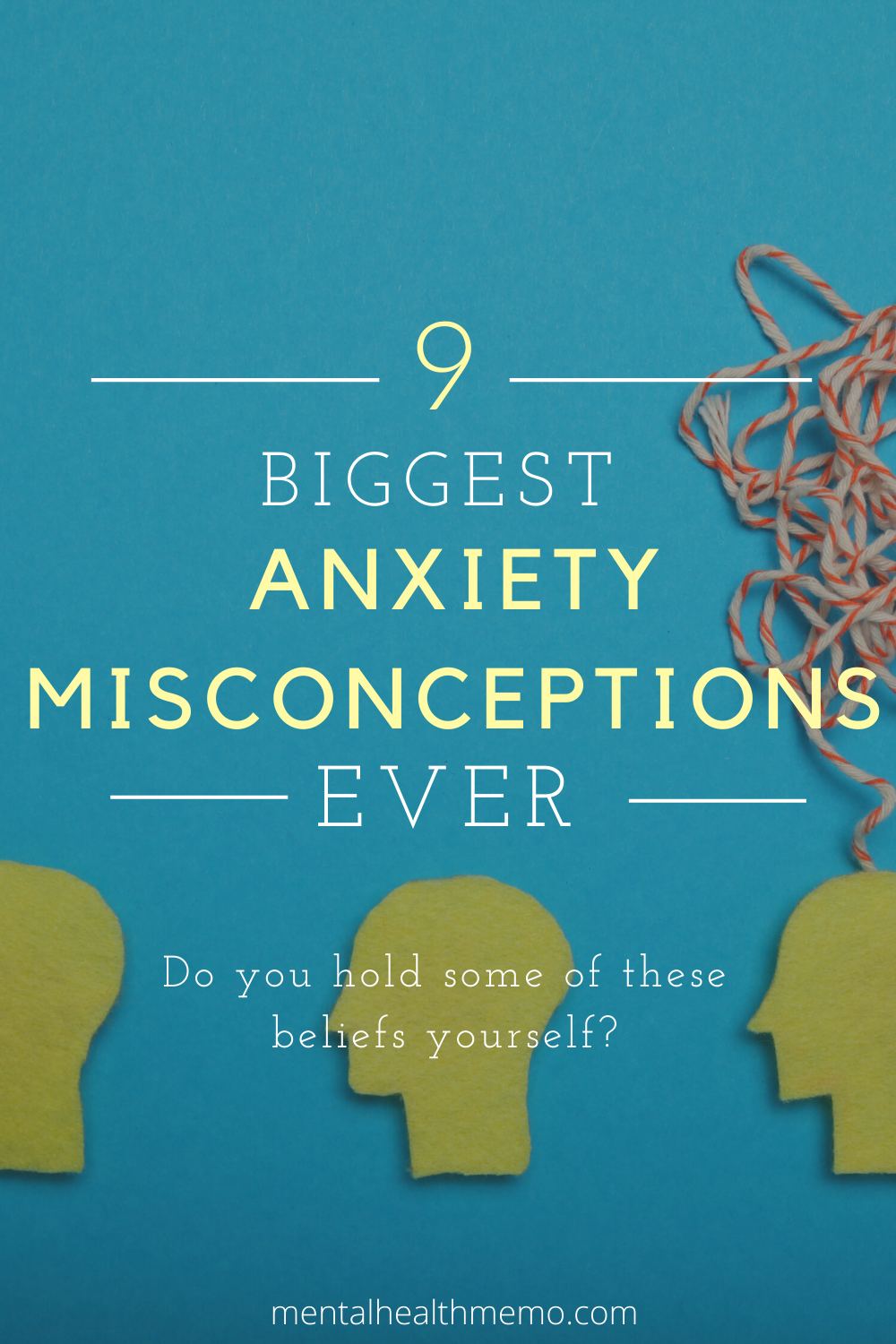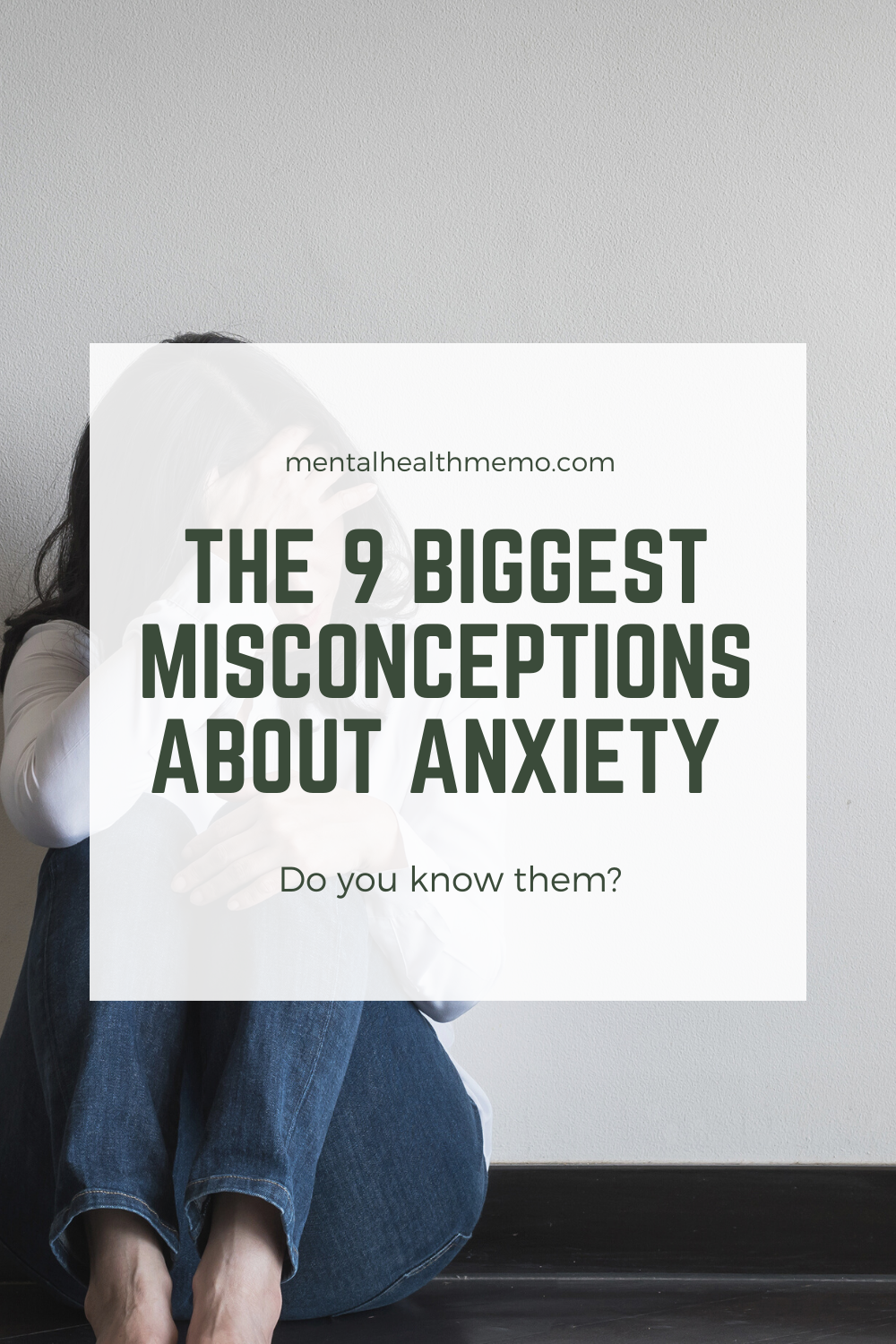Table of Contents
The Precursor
The mental health memo for today is: I don’t have enough fingers on my hands to count the number of times I’ve had to correct people on their misconceptions about anxiety. I need more hands!!!
It’s over 10 years now since I first got diagnosed with Panic Disorder and Agoraphobia. Within those short (long) 10 years, I’ve got to experience firsthand a lot of ignorant misunderstandings about anxiety.
From “Can’t you just… NOT be anxious?”, to “Have you tried float spas?”, to “When I’m anxious I just like to sit in my yard and relax, have you tried relaxing?”, I really HAVE heard it all.
And I get it, I can’t expect people to know about anxiety in as much detail as I do. On top of that, there is a lot of confusing information out there on anxiety and anxiety disorders.
Movies, books, shows, politicians, doctors, celebrities, psychologists; all these mediums tell us a different story about what anxiety is.
Within recent years, I have even seen a lot of romanticization of anxiety as something that’s “cute and quirky”. This has created a surge of people without anxiety talking about the subject as if they know what they’re talking about when… they don’t. (Also, If anyone would like to take my anxiety so they can be quirky, please feel free to reach out to me. I’d be happy to give it away to a good home)
Regardless, all I’m really trying to say here is I get it. I get how complicated the topic is. Even experts and specialists in the field have varying opinions. So it can be really hard to understand anxiety and anxiety disorders properly, especially if it’s not something relevant to your life.
However, that doesn’t mean we SHOULD be clueless about it. Just like we shouldn’t be clueless about politics even if we’re not all politicians.
It’s important to educate yourself so that you can identify anxiety in others, be a better support system, and just not make ignorant comments that ruin people’s days.
So in this post, I want to outline the 9 biggest misconceptions about anxiety that I’ve seen and heard in hopes of creating a better understanding for everyone of what anxiety is and isn’t. Shall we jump in?

What is Anxiety?
It seems fitting to start with what anxiety ACTUALLY is. Essentially, anxiety is our natural response to stress. It is typically a feeling of apprehension, worry, or fear of what’s to come in the near future.
Some symptoms of anxiety include:
- increased heart rate
- shortness of breath
- sweating
- restlessness
- trouble focusing
- difficult sleeping
While these are by no means all the symptoms, they are certainly the most common ones.
Examples of when you might feel anxious are:
- at a job interview
- during a first date
- when you have a test or exam
- before you go see a dentist or doctor
1. Misconceptions about anxiety #1:
Anxiety is a bad thing
Now, focus folks cause I’m really going to blow your mind here. ANXIETY IS NOT A BAD THING.
That is correct. Anxiety is not a bad thing. In fact, anxiety is a good thing!
I know this may seem confusing considering I previously offered to give away my anxiety to a good home. However, hear me out.
Anxiety in small amounts for situations that should elicit some anxiety is good for superior performance. For example, if you’re about to present in front of a crowd of people, anxiety will get your adrenaline going, it’ll make you hyperfocused, heavily determined, and put you in a condition where you can truly perform.
Additionally, anxiety acts as a warning sign to us when things are fishy, weird, or uncomfortable. By alerting us through sweating, labored breathing, and unease, we are able to make a decision to leave a potentially unsafe situation.
We run into issues with anxiety when anxiety is persistent, consistent, impacting our functioning, and is being activated in inappropriate circumstances. This is where we see anxiety disorders or maladaptive anxiety responses.
Let’s compare a maladaptive and adaptive anxiety response for the same scenario: a test.
Linda has an adaptive anxiety response. She has a test tomorrow and she’s nervous and anxious about it for a few days before it happens and on the day of. She knows she studied hard so she thinks that she’ll do okay but she’s still nervous about it. She prepares as much as she can the night before and goes to sleep. On the day of, she’s nervous but feels ready, focused, and sharp. Once the test is over, Linda’s body and mind are able to reset and stop feeling the anxiety.
Mary has a maladaptive anxiety response. She has the same test tomorrow and she has been worrying about it for weeks. She knows she studied but she still thinks she’s going to fail and she can’t stop thinking about the scenarios in which everything can go wrong. What if she doesn’t hear her alarm clock? What if she misses the bus and is late? Everyone is going to stare at her and she might not even be allowed to take the test anymore. What if she can’t remember anything? She tries to sleep but can’t because her thoughts are like a hamster on a wheel and will simply not stop. On the day of she’s jittery, unfocused, and very anxious. Once the test ends, her body does not unwind. She remains tight and rigid as she starts worrying about what she’s going to have for dinner and if she can get to the grocery store on time. What if it’s closed? What if she doesn’t have the money? The cycle continues.
As you can see, anxiety itself is not the problem but rather its persistence and how appropriate it is to our circumstances.
2. Misconceptions about anxiety #2:
You’re anxious because of something
A lot of people think if you’re anxious, there must be a reason for it. A test, a stressful job, or a toxic person, there has to be something, right? Well, not necessarily.
While a lot of times there are triggers for anxiety, sometimes there simply are none.
I get how this may be confusing especially if you don’t have any anxiety disorders. For folks that don’t have an anxiety disorder, the only time they feel anxious is when something happened to make them that way.
So I can understand why it would be hard to grasp the idea that sometimes there is simply no reason for the anxiety. Why would you ever be anxious if there’s no stressor or trigger? That’s where the disorder part comes in because it’s not “normal” behavior to be anxious with no reasoning.
However, even if it’s not “logical”, it is the reality for a lot of people. I’ll give a personal example: I experience a thing called Nighttime (Nocturnal) Panic Attacks. Long story short, I sometimes wake up into a panic attack while I’m sleeping.
Sleeping is probably the most peaceful thing on earth, and I’m not even conscious of it when it’s happening. Yet, despite having no trigger or even active consciousness, I still get panic attacks.
Does it make “sense”? No. At least not in a way that doesn’t require a lot of neuropsychological explanations.
Does it still happen? Yes.
So while technically you should only be anxious because of a reason/trigger/stressor, those with disordered anxiety might not always need one to be anxious.
If you are someone who doesn’t really experience anxiety, I hope now that you know this you can be more understanding towards people who tell you “I don’t know why I’m anxious right now.” Because they mean it despite how unimaginable it sounds.
3. Misconceptions about anxiety #3:
If you think logically you’ll calm down/ you can control your anxiety

This is one of the misconceptions about anxiety that drives me up the wall. Lord knows if I could logically think my way out of a panic attack or anxiety, I would have done so by now.
The phrase “There’s no reason to be anxious so just calm down” is one I’ve heard far too many times. And every time it has seized to be helpful.
If you’d like the angry personal explanation here it is: unfortunately, my brain and body are simultaneously self-combusting right now and no amount of logic is going to help me on this one because this anxiety response is maladaptive to being with. The whole concept of disordered anxiety goes against all logic. Do you think that I think this response is rational or justifiable? No! That’s why it’s a disorder! Trying to convince me it isn’t logical isn’t helpful because I already know that, and there’s nothing I can do about it. Instead, do something that is actually going to help.
Whew, that felt nice to get out!
Now, here is the SCIENTIFIC explanation as to why logic will NOT work in helping someone experiencing particularly high anxiety or a panic attack: when we are experiencing very high anxiety or a panic attack, our reptilian brain turns on and our higher-level thinking brain shuts off. I explained this in greater detail in one of my videos which you can check out here.
But essentially, our reptilian brain is the part of our brain associated with identifying threats and making decisions on how to survive when we are in danger. It elicits the response “fight, flight, or freeze”. When we are experiencing high levels of anxiety or a panic attack, this response gets triggered. When it gets triggered, it cuts contact with the part of our brain that does executive functions (logical thinking, problem-solving, etc)
So on a neurological level, people experiencing high levels of anxiety or a panic attack cannot see things logically in the moment. I hope that this scientific-based information can be helpful for those that don’t experience anxiety and might not understand why a person isn’t able to be reasoned with in moments such as these.
5. Misconceptions about anxiety #5:
A panic attack is the same as an anxiety attack
I have heard panic attack and anxiety attach used interchangeably both in my personal and (more strikingly) my professional life as a Social Worker.
I actually already wrote a more in-depth article about this subject which you can check out here if you’d like because it’s incredibly important to know the difference. These two responses being the same is also one of the biggest misconceptions about anxiety to-date.
For the purposes of this post, I’ll keep it short and sweet. A panic attack and an anxiety attack are actually completely different in various ways.
Most prominently, a panic attack comes from a fear response, whereas an anxiety attack stems from a stress response. This means that their symptoms and the severity of their symptoms will differ.
Since fear is a more intense emotion, panic attacks often can feel like you’re dying, suffocating, having a heart attack, or going mad.
Alternatively, anxiety attacks are more associated with a surge of worry and “what if’s”. While they are still intense and horrible, they are not considered as severe as panic attacks.
The reason this matters so much is that each condition will need a different type of response or support.
During a panic attack, the reptilian brain has completely taken over so de-escalation and making the person as comfortable as possible is suggested here.
Alternatively, there may be some more wiggle room in terms of talking with a person experiencing an anxiety attack. For example, using some cognitive exercises to address the worry they feel or even just letting them talk to relieve stress.
Regardless, knowing which one someone is experiencing is essential for being able to support properly.
6. Misconceptions about anxiety #6:
It’s only in your head

People seem to have this misconception that the brain is separate from the body. But it’s all intertwined. What affects the brain will affect the body and vice versa. Don’t forget that the brain is an organ just as much as your heart, kidneys, and stomach.
There are actually a lot of physical symptoms that accompany long term anxiety, anxiety attacks, and panic attacks.
Prolonged levels of anxiety can include fatigue, memory loss, heart problems, tight and sore muscles, headaches, and much more.
Panic attack physical symptoms can include the inability to breathe, heart racing, vomiting, hot and cold flashes, fainting, stomach pains, excessive sweating and more.
There is an abundance of research to indicate that anxiety and panic both in the short and longterm have severe physical symptoms to accompany them.
So please offer some support to your loved ones suffering from anxiety as it relates to their physical wellbeing too (massages for dayyyysss!)
7. Misconceptions about anxiety #7:
It’s obvious if someone is anxious
For whatever reason, we’ve created this stereotype of an anxious person. They’re always shy, awkward, quiet, fidgety, and weird. But that’s far from the truth.
You can have people with very severe anxiety that are loud, obnoxious, friendly, personable, charming, very put together, level headed and great leaders.
It really all depends on the person and their personality, as well as their ability to cope.
For example, I always come off as very social, loud, and put together. Most people are shocked when I tell them the extent of my anxiety disorder.
But that doesn’t mean I don’t have it.
Alternatively, I know people who have anxiety and fit that awkward shy stereotype to a T.
This is all to say that anxiety has many faces, and just because someone may not come off as anxious it doesn’t mean they aren’t. So check in with all your friends, even the ones you think are strong and in control!

8.Misconceptions about anxiety #8:
Stress is the same as anxiety
I always see this notion that stress is the same as anxiety. And while it may look similar, it isn’t exactly the same.
**First, it’s important to establish that both are normal, as previously discussed. What I’m comparing stress to here is specifically maladaptive anxiety**
Imagine stress looking like this:
- A heavy workload at school or at your job
- Running late
- Dealing with bad traffic
- Picking between a brownie or a cookie
- Needing to pay your bills on time
Imagine anxiety as:
- Freaking out that you’re going to fail your test because you’re not smart enough
- Not wanting to go to a social gathering because you’re uncomfortable and scared that you’ll be judged
- Feeling uneasy whenever you leave your house
- Being scared when entering a new classroom for the first time
- Thinking you’re going to die because you’re not breathing well and your heart is racing
As you can see, stress is something everyone experiences in some form in their lives simply by being a part of society.
Maladaptive anxiety is more so of an unrealistic or disordered worry that consumes you. It’s also important to note that excessive stress can be a precursor for getting maladaptive anxiety.
Being able to distinguish the difference between these two things is important to understand because the steps to getting better may differ.
For example, with stress you may just need to lessen what’s on your plate, time manage better, or even take a vacation. Alternatively, excessive and reoccurring anxiety may need the assistance of a mental health professional.

9. Misconceptions about anxiety #9:
Kids are immune to anxiety
We like to imagine that kids are pure and don’t experience dark feelings and thoughts but unfortunately, that’s not the case. Kids are not immune to mental illnesses.
I would actually argue that they are even more vulnerable to mental illnesses because their brains are still developing and even the smallest trauma or incident can impact them greatly.
However, it’s really hard to tell whether a kid is going through a growth spurt or if they’re actually having mental health issues. I’ve already written an article on what signs to look out for if you think your child has anxiety. This may be helpful if you’re trying to figure out what to look for.
For me, I used to have anxiety ever since I could remember. The problem was that I didn’t understand what I was feeling and I didn’t have a name to put to it. So I just had to live with it however I could as a child.
That’s why it’s so important to check in with kids too and see if there might be something wrong, as they are often overlooked due to their innocent nature.

To Sum it Up
Anxiety is not as straight forward as we have come to think. There are a lot of complications and things that need to be understood for us to be able to help those that suffer from it.
It also doesn’t help that the media construes a false imagine of anxiety which further solidifies many misconceptions about anxiety.
I hope you learned something new while reading my post, and can now be an even better ally to those around you that have anxiety.
All my love,
T

